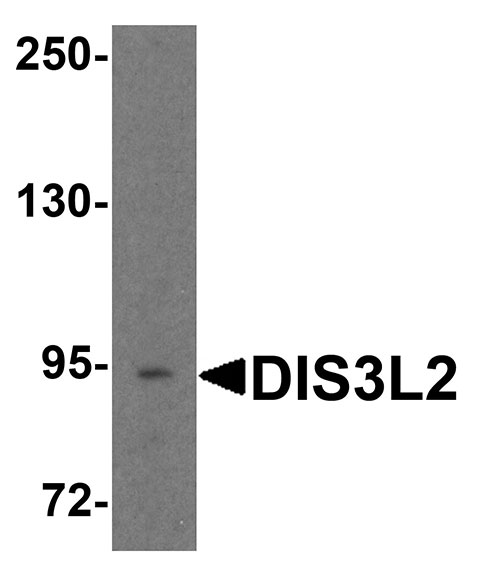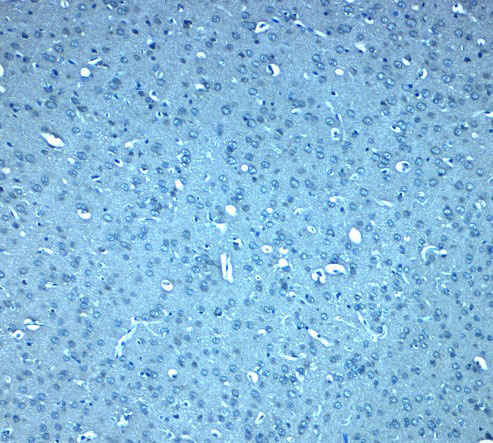DIS3L2 Antibody
- SPECIFICATION
- CITATIONS
- PROTOCOLS
- BACKGROUND

Application
| WB, E |
|---|---|
| Primary Accession | Q8IYB7 |
| Other Accession | NP_689596, 134288890 |
| Reactivity | Human, Mouse, Rat |
| Host | Rabbit |
| Clonality | Polyclonal |
| Isotype | IgG |
| Calculated MW | Predicted: 97 kDa; Observed: 94 kDa |
| Application Notes | DIS3L2 antibody can be used for detection of DIS3L2 by Western blot at 1 - 2 µg/ml. Antibody can also be used for immunohistochemistry starting at 5 µg/mL. |
| Gene ID | 129563 |
|---|---|
| Target/Specificity | DIS3L2; DIS3L2 antibody is human, mouse and rat reactive. At least three isoforms of DIS3L2 are known to exist; this antibody will only detect the longest isoform. DIS3L2 is predicted to not cross-react with DIS3 or DIS3L. |
| Reconstitution & Storage | DIS3L2 antibody can be stored at 4℃ for three months and -20℃, stable for up to one year. |
| Precautions | DIS3L2 Antibody is for research use only and not for use in diagnostic or therapeutic procedures. |
| Name | DIS3L2 {ECO:0000255|HAMAP-Rule:MF_03045} |
|---|---|
| Synonyms | FAM6A |
| Function | 3'-5'-exoribonuclease that specifically recognizes RNAs polyuridylated at their 3' end and mediates their degradation. Component of an exosome-independent RNA degradation pathway that mediates degradation of both mRNAs and miRNAs that have been polyuridylated by a terminal uridylyltransferase, such as ZCCHC11/TUT4. Mediates degradation of cytoplasmic mRNAs that have been deadenylated and subsequently uridylated at their 3'. Mediates degradation of uridylated pre-let-7 miRNAs, contributing to the maintenance of embryonic stem (ES) cells. Essential for correct mitosis, and negatively regulates cell proliferation. |
| Cellular Location | Cytoplasm. Cytoplasm, P-body |

Thousands of laboratories across the world have published research that depended on the performance of antibodies from Abcepta to advance their research. Check out links to articles that cite our products in major peer-reviewed journals, organized by research category.
info@abcepta.com, and receive a free "I Love Antibodies" mug.
Provided below are standard protocols that you may find useful for product applications.
Background
The exosome is involved in a multitude of cellular RNA processing and degradation events (1). DIS3, also known as exosome complex exonuclease RRP44, is a ribonuclease that acts directly in the processing, turnover, and surveillance of a large number of distinct RNA species (2). DIS3L2 is a paralog of DIS3, but unlike DIS3 is located in the cytoplasm (3). DIS3L2 defines a novel eukaryotic RNA degradation pathway and preferentially targets uridylated RNA (4). DIS3L2 mutations have also been associated with sporadic Wilms tumors (3).
References
Chen CY, Gherzi R, Ong SE, et al. AU binding proteins recruit the exosome to degrade ARE-containing mRNAs. Cell 2001; 107:451-64.
Brouwer R, Allmang C, Raijmakers R, et al. Three novel components of the human exosome. J. Biol. Chem. 2001; 276:6177-84.
Astuti D, Morris MR, Cooper WN, et al. Germline mutations in DIS3L2 cause the Perlman syndrome of overgrowth and Wilms tumor susceptibility. Nat. Genet. 2012; 44:277-84.
Malecki M, Viegas SC, Carneiro T, et al. The exonuclease Dis3L2 defines a novel eukaryotic RNA degradation pathway. EMBO J. 2013; 32:1842-54.
If you have used an Abcepta product and would like to share how it has performed, please click on the "Submit Review" button and provide the requested information. Our staff will examine and post your review and contact you if needed.
If you have any additional inquiries please email technical services at tech@abcepta.com.













 Foundational characteristics of cancer include proliferation, angiogenesis, migration, evasion of apoptosis, and cellular immortality. Find key markers for these cellular processes and antibodies to detect them.
Foundational characteristics of cancer include proliferation, angiogenesis, migration, evasion of apoptosis, and cellular immortality. Find key markers for these cellular processes and antibodies to detect them. The SUMOplot™ Analysis Program predicts and scores sumoylation sites in your protein. SUMOylation is a post-translational modification involved in various cellular processes, such as nuclear-cytosolic transport, transcriptional regulation, apoptosis, protein stability, response to stress, and progression through the cell cycle.
The SUMOplot™ Analysis Program predicts and scores sumoylation sites in your protein. SUMOylation is a post-translational modification involved in various cellular processes, such as nuclear-cytosolic transport, transcriptional regulation, apoptosis, protein stability, response to stress, and progression through the cell cycle. The Autophagy Receptor Motif Plotter predicts and scores autophagy receptor binding sites in your protein. Identifying proteins connected to this pathway is critical to understanding the role of autophagy in physiological as well as pathological processes such as development, differentiation, neurodegenerative diseases, stress, infection, and cancer.
The Autophagy Receptor Motif Plotter predicts and scores autophagy receptor binding sites in your protein. Identifying proteins connected to this pathway is critical to understanding the role of autophagy in physiological as well as pathological processes such as development, differentiation, neurodegenerative diseases, stress, infection, and cancer.



